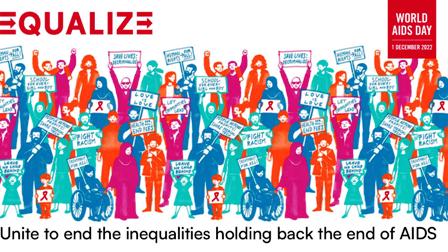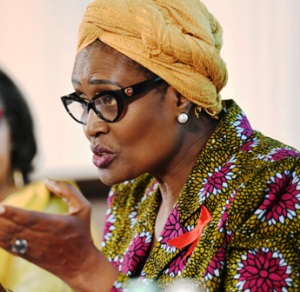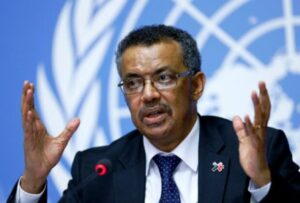“Of the 38 million people living with HIV, 5.9 million people who know they have HIV are not receiving treatment”
As the world marks the World AIDS Day today, December 1, there are indications that the world will not meet agreed global targets on AIDS as analysis by the UN has revealed that inequalities are obstructing the end of the pandemic. But the new UNAIDS report, Dangerous Inequalities, shows that urgent action to tackle inequalities can get the AIDS response on track.
In a statement to mark the 2022 World AIDS Day, UNAIDS said its new report revealed that inequalities are the underlying reason for the rising new infections and continuing deaths in many parts of the world and showed how world leaders can tackle those inequalities,. The agency called on the leaders to be courageous to follow what the evidence reveals.
“The world will not be able to defeat AIDS while reinforcing patriarchy,” said UNAIDS Executive Director, Winnie Byanyima. “We need to address the intersecting inequalities women face. In areas of high HIV burden, women subjected to intimate partner violence face up to a 50% higher chance of acquiring HIV. Across 33 countries from 2015-2021 only 41% of married women aged 15-24 could make their own decisions on sexual health.
“The only effective route map to ending AIDS, achieving the sustainable development goals and ensuring health, rights and shared prosperity, is a feminist route map. Women’s rights organizations and movements are already on the frontlines doing this bold work. Leaders need to support them and learn from them.”
The statement disclosed that the effects of gender inequalities on women’s HIV risks are especially pronounced in sub- Saharan Africa, where women accounted for 63% of new HIV infections in 2021.
“Adolescent girls and young women (aged 15 to 24 years) are three times more likely to acquire HIV than adolescent boys and young men of the same age group in sub-Saharan Africa. The driving factor is power.
“One study showed that enabling girls to stay in school until they complete secondary education reduces their vulnerability to HIV infection by up to 50%. When this is reinforced with a package of empowerment support, girls’ risks are reduced even further. Leaders need to ensure all girls are in school, are protected from violence which is often normalized including through underage marriages, and have economic pathways that guarantee them a hopeful future.
WHO calls on world leaders to address inequalities
The World Health Organization (WHO) on its part also called on global leaders and citizens to boldly recognize and address the inequalities that are holding back progress in attaining the global goal to end AIDS by 2030.
“With global solidarity and bold leadership, we can make sure everyone receives the care they need,” said Dr Tedros Adhanom Ghebreyesus, WHO Director-General. “World AIDS Day is an opportunity to re-affirm and refocus on our shared commitment to end AIDS as a public health threat by 2030.”
According to WHO, HIV remains a major public health issue that affects millions of people worldwide. But our response is at risk of falling behind.
- Of the 38 million people living with HIV, 5.9 million people who know they have HIV are not receiving treatment.
- A further 4 million people living with HIV have not yet been diagnosed.
- While 76% of adults overall were receiving antiretroviral treatment that help them lead normal and healthy lives, only 52% of children living with HIV were accessing this treatment globally in 2021.
- 70% of new HIV infections are among people who are marginalized and often criminalized.
- While transmission has declined overall in Africa, there has been no significant decline among men who have sex with men – a key population group – in the past 10 years.
In its World AIDS Day statement, UNICEF warned that progress in HIV prevention and treatment for children, adolescents, and pregnant women has nearly flat lined over the past three years and many regions are still not at pre-COVID-19 service coverage. This comes on top of an existing and growing gap in treatment between children and adults.
2.7 million young people living with HIV – UNICEF
UNICEF revealed that around 110,000 children and adolescents (0-19 years) died from AIDs-related causes during 2021, according to the latest UNICEF global snapshot on children and HIV and AIDS. Meanwhile, another 310,000 were newly infected, bringing the total number of young people living with HIV to 2.7 million.
“Though children have long lagged behind adults in the AIDS response, the stagnation seen in the last three years is unprecedented, putting too many young lives at risk of sickness and death,” said UNICEF Associate Chief of HIV/AIDS Anurita Bains. “Children are falling through the cracks because we are collectively failing to find and test them and get them on life-saving treatment. Every day that goes by without progress, over 300 children and adolescents lose their fight against AIDS.”
The statement said children and adolescents comprised 17 per cent of all AIDS-related deaths, and 21 per cent of new HIV infections in 2021 despite accounting for only 7 per cent of overall people living with HIV.
“Between 2014 and 2021, the number of new infections among children and adolescents aged 0 to 14 decreased globally by roughly 27%, but it rose by 13% in Nigeria. Unless the drivers of inequities are addressed, UNICEF warns, ending AIDS in children and adolescents will continue to be a distant dream.
“However, the snapshot points out that longer-term trends remain positive. New HIV infections among younger children (0-14 years) dropped by 52 per cent from 2010 to 2021, and new infections among adolescents (15-19 years) also dropped by 40 per cent .Similarly, coverage of lifelong antiretroviral treatment (ART) among pregnant women living with HIV increased from 46 per cent to 81 per cent in a single decade.
“In the last seven years, the percentage of pregnant women with HIV who are receiving lifetime antiretroviral treatment (ART) grew slightly from 79% to 81% globally but declined from 57% to 34% in Nigeria.
“While the total number of children living with HIV is on the decline, the treatment gap between children and adults continues to grow. In UNICEF HIV-priority countries, ART coverage for children stood at 56 per cent in 2020 but fell to 54 per cent in 2021.
“This decline is due to several factors including the COVID-19 pandemic and other global crises, which have increased marginalisation and poverty, but is also a reflection of waning political will and a flagging AIDS response in children. Globally, an even lower percentage of children living,” UNICEF said.



